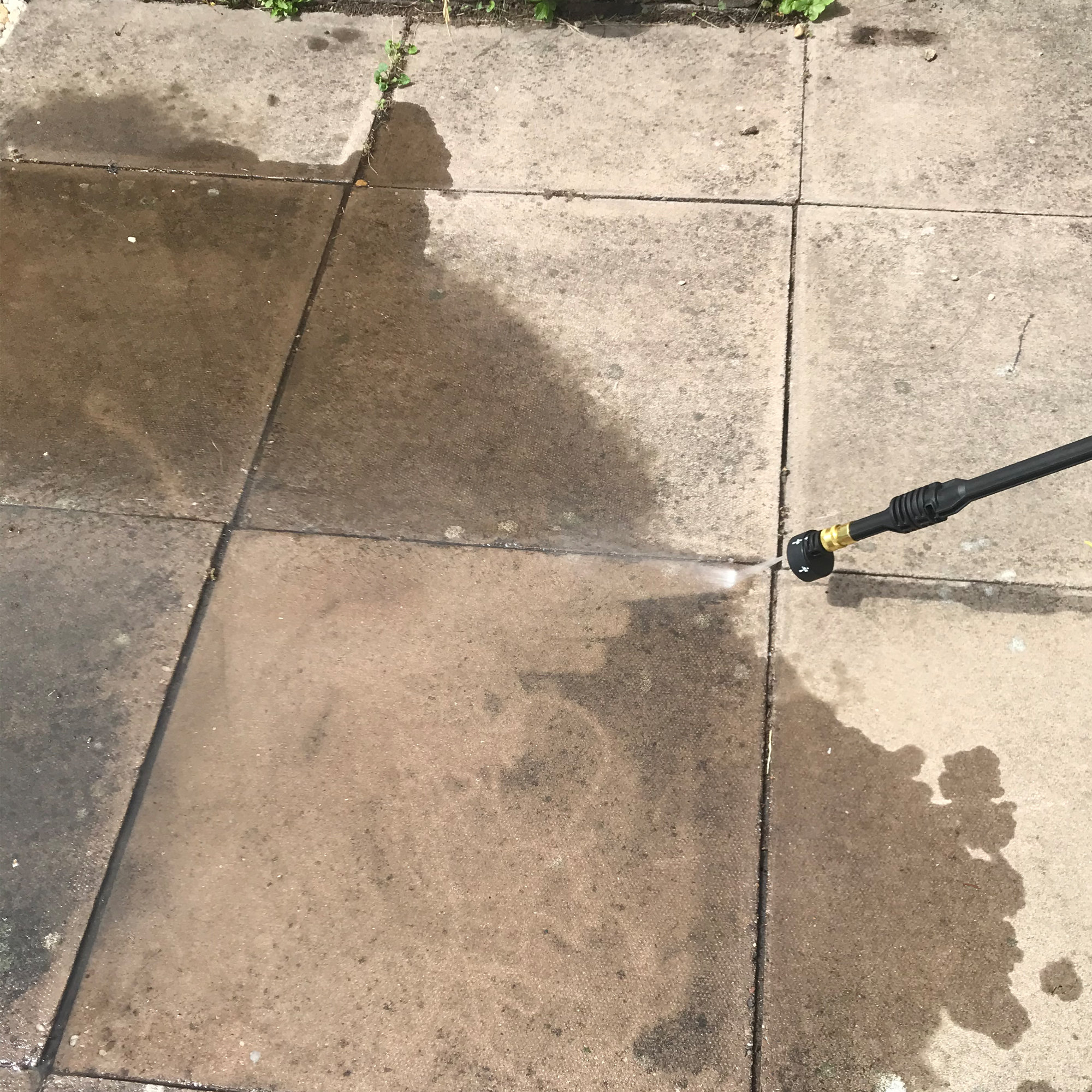How to clean a driveway with a pressure washer in 6 easy steps
It’s time to boost your curb appeal


A pressure washer is a worthwhile investment for those looking to easily clean a patio, wash their car, smarten up their garden furniture, and clean a driveway. But how do you clean a driveway with a pressure washer?
Whether you’ve spent time and money designing a new driveway idea or you just want to breathe new life into your old driveway, the best pressure washers are on hand to help. However, this garden gadget isn’t something you can use without proper research, care, or attention.
You need to know how to use a pressure washer properly, and you also need to know how to use this gadget and its accessories to clean your driveway successfully without damaging it in the process. Thankfully, it’s pretty easy, which is good news if you're looking to prepare your driveway for winter.
How to clean a driveway with a pressure washer
Mucky tyres and wet weather can wreak havoc on your driveway, but cleaning up your driveway can instantly boost your home’s curb appeal. And while you can do this by hand, it’s much easier to do this with a pressure washer. All you need to do is follow these 6 easy steps.

What you'll need
- Pressure washer - our favourite is the Karcher K4 Full Control Home Pressure Washer from Amazon
- Eye goggles - like these Blackrock Clear Safety Goggles from Amazon
- Cleaning agent - like this Algon Organic Path Patio Decking Cleaner from B&Q
- OR
- Washing up liquid
- Water
Step-by-step
1. Check pressure washing is the best option
Before you get your pressure washer out of the shed, it’s important to make sure that pressure washing your driveway is the best option.
Tom Clifford, Gardenstone's garden landscaping expert, explains, ‘Pressure washing is effective on the majority of driveways, but for certain materials, it can be too harsh and cause considerable damage.’
‘Materials like sandstone are far too delicate to use pressure on, even with the weakest nozzle attachment. It is crucial that you conduct research before pressure washing your driveway to ensure that it is not susceptible to damage.’
So, it’s best to do your due diligence if you don’t want to replace broken stones or completely replace your driveway. In some cases, you may have to clean your patio by hand - perhaps with the help of some washing powder.

2. Consider using a cleaning agent
One of the things we love most about pressure washers is that you don’t have to use any chemicals if you don’t want to. The pressure of the water alone is enough to lift grime and dirt, but you still might want to consider using a cleaning agent if you’re short on time or have particularly stubborn stains.
‘Although pressure washing is efficient in removing tough stains and grime, this often requires prolonged use, which has the potential to damage the surface of your driveway,’ says Tom.
‘Using a mild detergent or cleaning agent can help to loosen dirt and grime build up on the surface of your driveway to speed up the pressure washing process considerably and prevent damage to your paving. Do not use cleaning agents with harsh chemicals as this can result in damage.’
Instead, opt for natural cleaners or something gentle like washing up liquid and water.
3. Prep yourself and the area
Pressure washers are popular because of their pressure, and these gadgets can be extremely powerful. So, prepping yourself and the area is key.
First, it’s always a good idea to clear the driveway of anything that can get in the way, such as cars, dustbins, pots and planters. Nick Ee, product and training manager at BLACK+DECKER, also suggests giving your driveway a quick pre-clean.
‘To make the cleaning process easier, it is best to sweep or blow away any loose debris like leaves or dirt from your driveway, this way, you can see what you’re working with,’ he says.
When you’ve done that, you should then prep yourself so you can keep safe throughout the whole pressure washing process.
Nick says, ‘Before you begin, you must ensure you have all the proper safety measurements in place. I would always recommend wearing protective gear, especially safety goggles when pressure washing to protect your eyes from debris.’
If you haven’t pressure-washed your driveway before, he also suggests a pre-test. 'If you’re unsure about what setting to have your pressure washer on, test the pressure on a small area of the drive to ensure the pressure and speed are suitable for the surface without causing damage,’ he explains.

4. Use the appropriate nozzles
Most of the pressure washers on the market today come with various different nozzles. These nozzles all have their own specific uses and allow you to customise the strength of the water stream, which is why it’s important to choose the most appropriate ones when cleaning a driveway with a pressure washer.
Tom says, ‘A twenty-five-degree nozzle is the perfect choice for cleaning the majority of your driveway, it provides enough pressure to remove stains and dirt while not damaging the surface of your paving.’
‘If there are small areas of really stubborn dirt, you can carefully use a fifteen-degree nozzle. This is used for heavy-duty cleaning, so only use it on small sections for short periods of time.’
5. Use slow, even strokes
When you’ve prepped the area, yourself, and chosen the appropriate nozzle for the job, you can then get started on pressure washing the driveway. And while you could go gung-ho and clean in a way that works for you, Nick has suggested a foolproof technique.
‘Once you’ve made all the appropriate checks, start at one end of the driveway using slow and even strokes to work your way across the surface, holding the nozzle wand at a slight angle and about 12-18 inches from the surface to avoid damage,’ he says.
‘To remove those stubborn black spots, focus the pressure washer on the stain and move the wand closer if necessary. Always be extra cautious on grout lines as the pressure can loosen them.’
If the grout in your driveway was already loose, you may need to replace it. Something like this Sika FastFix Ready Mixed Quick Dry Jointing Compound should do the trick.

6. Allow the driveway to air dry
If you’ve pressure washed your entire driveway and you’re happy with the results, you should then allow the driveway to air dry. During this time, you should avoid putting anything back on the driveway - especially any cars.
Because of this, it’s best to clean a driveway with a pressure washer on a warm and sunny day when there’s no chance of rain.
When it’s dry, you can also inspect your driveway to ensure you haven’t missed any spots. If you have, simply repeat the process above.
FAQs
What do you spray on driveway before pressure washing?
Ideally, you shouldn’t spray anything on your driveway before pressure washing it. The act of pressure washing can put a lot of strain on your driveway - especially if it’s made from softer stone - and you don’t want to add anything else that’s going to compromise it in any way.
If you have a particularly grimy driveway, however, you could use an organic, chemical-free cleaner or a mixture of warm water and washing-up liquid. This will help to clean the driveway in a gentle and natural way.
Is it OK to pressure wash a driveway?
Yes, as long as you do your research before pressure washing your driveway. Although most driveways should be safe to pressure wash, softer materials are too fragile for such a high-pressure situation.
For example, you should never pressure wash a sandstone driveway. You’ll have to hand-clean it instead.
No pressure, but your dirty driveway is waiting!
Get the Ideal Home Newsletter
Sign up to our newsletter for style and decor inspiration, house makeovers, project advice and more.

Lauren Bradbury has been the Content Editor for the House Manual section since January 2025 but worked with the team as a freelancer for a year and a half before that. She graduated with a Bachelor’s degree in English and Creative Writing from the University of Chichester in 2016. Then, she dipped her toe into the world of content writing, primarily focusing on home content. After years of agency work, she decided to take the plunge and become a full-time freelancer for online publications, including Real Homes and Ideal Home, before taking on this permanent role. Now, she spends her days searching for the best decluttering and cleaning hacks and creating handy how-to guides for homeowners and renters alike, as well as testing vacuums as part of her role as the Ideal Home Certified Expert in Training on Vacuums, having spent over 110 hours testing different vacuum models to date!
-
 My go-to Ninja coffee machine is on sale for Easter weekend
My go-to Ninja coffee machine is on sale for Easter weekendIt makes coffee shop quality achievable at home
By Molly Cleary
-
 When to plant out annual flowering plants for vibrant, colourful garden borders – and give them the best start, according to experts
When to plant out annual flowering plants for vibrant, colourful garden borders – and give them the best start, according to expertsNot sure when to plant out annual flowering plants? We've got you covered...
By Kayleigh Dray
-
 I'm a kitchen decor editor and didn't like this tableware trend - until I saw H&M Home's designer-look plates
I'm a kitchen decor editor and didn't like this tableware trend - until I saw H&M Home's designer-look platesThey made it easy to justify a new crockery set
By Holly Cockburn